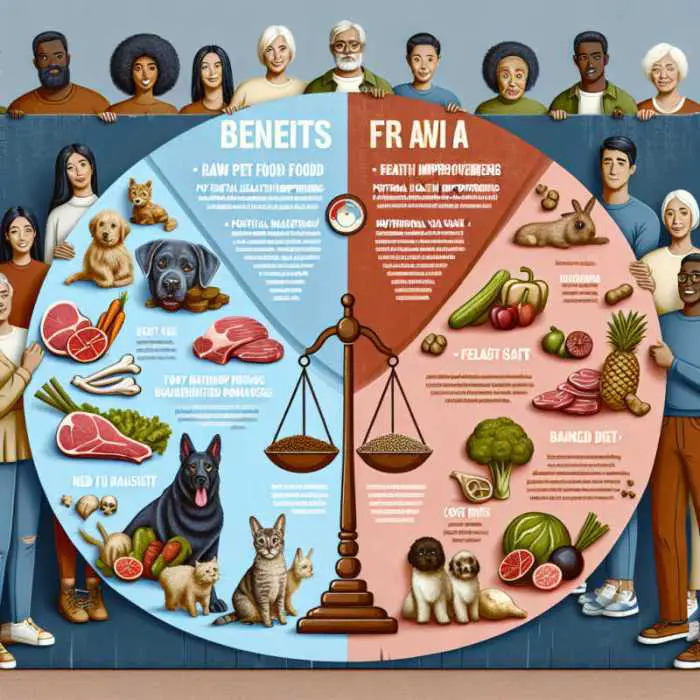
People standing behind a banner promoting pet food.
Did you know that nearly 20% of pet owners in the UK have switched to raw pet food, driven by the promise of improved health and vitality for their furry friends?
As more pet parents seek to optimize their pets’ diets, the raw food trend has gained significant traction, boasting numerous nutritional benefits but also facing its fair share of myths and challenges.
This article delves into the essential nutrients found in raw pet food and their health benefits, debunks common misconceptions with expert insights, and highlights potential risks such as bacterial contamination.
We’ll also guide you through the transition process to a raw diet, compare costs with commercial pet food, and provide actionable tips to ensure a smooth and safe switch for your pet. Whether you’re a seasoned raw feeder or just curious, this comprehensive guide aims to equip you with the knowledge to make informed decisions for your pet’s well-being.
Understanding the Nutritional Benefits of Raw Pet Food
When it comes to feeding our furry friends, the debate between raw pet food and commercial options is heating up. Advocates of raw diets argue that they provide a more natural and nutrient-rich alternative. But what exactly makes raw pet food so beneficial?
First off, raw pet food is packed with key nutrients that are often lost in the processing of commercial pet foods. These include:
- Proteins: Essential for muscle growth and repair.
- Vitamins: Such as Vitamin A for vision and immune function, and Vitamin D for bone health.
- Minerals: Including calcium and phosphorus for strong bones and teeth.
- Enzymes: Aid in digestion and nutrient absorption.
Common ingredients in raw pet food include raw meat, organs, and bone, which are rich in these nutrients. For example, raw chicken provides high levels of protein and essential fatty acids, while the liver is a powerhouse of vitamins and minerals.
| Nutrient | Raw Pet Food | Commercial Pet Food |
|---|---|---|
| Protein | High | Moderate |
| Vitamins | High | Variable |
| Minerals | High | Variable |
| Enzymes | Present | Absent |
Switching to a raw diet can lead to noticeable improvements in your pet’s health. Many pet owners report shinier coats, healthier skin, and increased energy levels.
The high protein content supports muscle development, while the abundance of vitamins and minerals boosts overall well-being.
Common Myths and Misconceptions About Raw Feeding
When it comes to raw pet food, there’s no shortage of myths and misconceptions floating around. Let’s dive into some of the most popular ones and set the record straight with evidence-based counterarguments. You’ll be surprised at how many of these myths are just plain wrong.
- Myth: Raw food is dangerous and can cause bacterial infections in pets.
Fact: While it’s true that raw food can contain bacteria, pets have a much stronger stomach acid than humans, which helps them handle these bacteria. According to Dr. Karen Becker, a renowned veterinarian, Properly handled and prepared raw food poses no more risk than commercial pet food. - Myth: Raw diets are not nutritionally balanced.
Fact: A well-planned raw diet can be perfectly balanced. Dr. Ian Billinghurst, a pioneer in raw feeding, states that raw diets can be tailored to meet all nutritional needs of pets, often better than processed foods. - Myth: Raw feeding is too expensive and time-consuming.
Fact: While it may require more effort than opening a can, many pet owners find that the health benefits and reduced vet bills make it worthwhile. Plus, bulk buying and meal prepping can significantly cut costs and time.
It’s crucial to rely on expert opinions and scientific evidence when considering a raw diet for your pet. Don’t let these myths deter you from exploring what could be a healthier option for your furry friend.
Potential Risks and Challenges of Raw Pet Food
Feeding your pet a raw diet might sound like a great idea, but it comes with its own set of risks and challenges. One of the most significant concerns is bacterial contamination.
Raw meat can harbor harmful bacteria like Salmonella and E. coli, which can pose serious health risks not only to your pet but also to you and your family.
For instance, there have been cases where pets on a raw diet have transmitted these bacteria to their owners, leading to severe illnesses.
To mitigate this risk, always source your raw ingredients from reputable suppliers and ensure proper handling and storage.
Another challenge is sourcing quality ingredients. Not all raw meats are created equal, and finding high-quality, fresh ingredients can be a daunting task.
Pet owners often struggle with identifying trustworthy suppliers who provide meats free from hormones and antibiotics.
One way to tackle this issue is by building a relationship with local butchers or farmers who can guarantee the quality of their products. Additionally, consider consulting with a veterinary nutritionist to ensure your pet’s diet is balanced and meets all nutritional requirements.
Despite these challenges, many pet owners find the benefits of a raw diet outweigh the risks. However, it’s crucial to be well-informed and take necessary precautions to ensure the health and safety of your pet and household.
By understanding the potential pitfalls and taking proactive steps, you can provide a nutritious and safe raw diet for your furry friend.
Transitioning Your Pet to a Raw Food Diet
Switching your pet to a raw food diet can be a game-changer, but it requires careful planning and monitoring. Here’s a step-by-step guide to ensure a smooth transition:
- Start Slowly: Begin by mixing a small amount of raw food with your pet’s current diet. Gradually increase the proportion of raw food over a week.
- Monitor Health: Keep an eye on your pet’s health during the transition. Look for changes in energy levels, coat condition, and stool quality. If you notice any adverse reactions, consult your vet immediately.
- Sample Meal Plan: For the first week, you can follow this plan:
- Day 1-2: 75% current food, 25% raw food
- Day 3-4: 50% current food, 50% raw food
- Day 5-6: 25% current food, 75% raw food
- Day 7: 100% raw food
Case studies have shown that pets transitioning to a raw diet often experience improved digestion, shinier coats, and higher energy levels. However, it’s crucial to tailor the diet to your pet’s specific needs and consult with a veterinarian to ensure a balanced nutritional intake.
Cost Analysis: Raw Pet Food vs. Commercial Pet Food
When it comes to the cost of feeding your pet, the debate between raw pet food and commercial pet food is more than just about the price tag.
Let’s dive into the financial implications of both options. On the surface, raw pet food might seem pricier due to the initial investment in high-quality meats, organs, and supplements. However, a closer look reveals potential long-term savings.
For instance, many pet owners report fewer visits to the vet, thanks to the health benefits of a raw diet, which can translate to significant savings over time.
On the other hand, commercial pet food often appears cheaper upfront. But don’t be fooled by the lower price per bag. The hidden costs, such as frequent vet visits due to dietary-related health issues, can add up. To give you a clearer picture, here’s a breakdown of the expenses:
| Expense | Raw Pet Food | Commercial Pet Food |
|---|---|---|
| Monthly Food Cost | £100 – £150 | £50 – £80 |
| Annual Vet Bills | £200 – £400 | £500 – £800 |
| Supplements | £50 – £100 | £20 – £50 |
As you can see, while the monthly cost of raw pet food might be higher, the annual savings on vet bills can be substantial.
Case studies have shown that pets on a raw diet often experience improved health, leading to fewer medical issues and lower overall costs. So, before you make a decision, consider the long-term financial benefits of investing in your pet’s health with a raw diet.
Frequently Asked Questions
1. How do I know if my pet is allergic to raw food ingredients?
If your pet shows signs of allergies such as itching, digestive issues, or ear infections after starting a raw food diet, it may be allergic to one of the ingredients. Consult your veterinarian for allergy testing and consider an elimination diet to identify the culprit.
2. Can I mix raw food with commercial pet food?
Yes, you can mix raw food with commercial pet food, but it’s important to ensure that the combined diet is balanced and meets your pet’s nutritional needs. Gradually introduce raw food to avoid digestive upset and consult your veterinarian for guidance.
3. How should I store raw pet food to ensure its safety?
Raw pet food should be stored in the freezer until ready to use. Thaw it in the refrigerator and use it within 2-3 days. Always handle raw food with clean hands and utensils to prevent bacterial contamination.
4. Are there specific raw food diets for different life stages of pets?
Yes, raw food diets can be tailored to different life stages, such as puppies, adults, and seniors. Each stage has unique nutritional requirements, so it’s important to choose or formulate a diet that meets those needs. Consult a pet nutrition expert for advice.
5. What should I do if my pet refuses to eat raw food?
If your pet refuses to eat raw food, try mixing it with their current food and gradually increasing the raw portion. You can also lightly cook the raw food to make it more appealing. If refusal persists, consult your veterinarian to rule out any underlying health issues. t5





